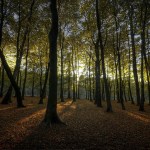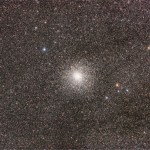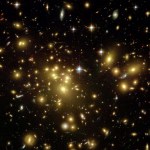Astronomy
Wandering into the woods unprepared and without a plan sounds like a terrible idea. But if you're interested in scientific exploration at the frontiers, confronting the unknown with whatever you happen to have at your disposal, you have to take that risk. You have to be willing to take those steps. And you have to be okay with putting your best ideas out there -- for all to see -- knowing full well that you might get the entire thing wrong.
Image Credit: Arthur Eddington, Fundamental Theory.
Sometimes, that's indeed what happens. Some of the most revered and famous scientific minds in…
“The human mind is capable of excitement without the application of gross and violent stimulants; and he must have a very faint perception of its beauty and dignity who does not know this.” -William Wordsworth
Galaxies may be the most common type of object identified in the Messier catalogue, and considering that there are at least hundreds of billions of them in the Universe, you might think that Milky Way-type galaxies are everywhere. But it's not Milky Way-types that make up most of the Universe, it's this guy.
Image credit: Jim M., via http://justvisitinghappyvalley.blogspot.com/…
“The most amazing lesson in aerodynamics I ever had was the day I climbed a thermal in a glider at the same time as an eagle. I witnessed, close up, effortlessness and lightness combined with strength, precision and determination.” -Norman Foster
It's called the "Eagle Nebula" because the shape of the nebula itself faintly resembles the silhouette of that hyper-intelligent and skilled bird-of-prey, but what lies inside is far more spectacular than any early skywatcher imagined.
Image credit: Rogelio Bernal Andreo, via http://www.deepskycolors.com/archivo/2008/06/07/messier-16-The-Eagle-Ne…
“For in the final analysis, our most basic common link is that we all inhabit this small planet. We all breathe the same air. We all cherish our children’s futures. And we are all mortal.” -John F. Kennedy
If you went back in time to the birth of the Sun and the Solar System, what would you see? You wouldn't simply have a protostar with a gas-and-dust filled nebula around it, with the seeds of what would become our planets. Sure, they would be there, but they'd be immersed in a giant molecular gas cloud with hundreds-to-thousands of stars just like ours, as well as some that were far…
“But certainly the laser proved to be what I realized it was going to be. At that moment in my life I was too ignorant in business law to be able to do it right, and if I did it over again probably the same damn thing would happen.” -Gordon Gould, inventor of the LASER
If you want the best telescopic view of the Universe, you build the biggest telescope you can, you outfit it with the best camera(s) you can, and you send it to space. Right?
Image credit: Fort Lewis College Observatory, via http://www.fortlewis.edu/.
Well, unfortunately, quite often you can't. If you want to build the…
“I love the sea’s sounds and the way it reflects the sky. The colours that shimmer across its surface are unbelievable.” -John Dyer
When you look up into the night sky, most of the fixed, non-stellar objects you see are faint, extended and diffuse. One of the things that surprises most skywatchers is what a galaxy or nebula actually looks like through an eyepiece; it's nothing like the astrophotos that you see.
Image credit: N.A.Sharp, REU program/AURA/NOAO/NSF.
But there are some relatively close clusters -- both star clusters and globular clusters -- that are exceptions, and are…
“Language… has created the word ‘loneliness’ to express the pain of being alone. And it has created the word ‘solitude’ to express the glory of being alone.” -Paul Tillich
One of the biggest questions in all of science is that of just how ubiquitous -- or rare -- life in the Universe is. With the sole exception of Earth, all the worlds in our Solar System seem devoid of life. Or at least, their detection has eluded us so far. But what of all the other planets, star systems and galaxies in the Universe?
Image credit: Robert Gendler of http://www.robgendlerastropics.com/Biography.…
“The only thing I have learnt over the years is that if you enjoy your work and put in the best efforts, it will show. If you follow this process, things work out. But if you go chasing a formula, success will elude you.” -Mahesh Babu
When you know something is there but you can't find it for yourself, it makes the search all the more maddening. Yet this exactly was the case for Charles Messier, hunting a catalogued object by a colleague of his for fourteen years before he finally found it!
Image credit: Jim Mazur’s Astrophotography, via Skyledge at http://www.skyledge.net/Messier55.htm…
“It surprises me how disinterested we are today about things like physics, space, the universe and philosophy of our existence, our purpose, our final destination. It’s a crazy world out there. Be curious.” -Stephen Hawking
The story of where everything came from in the Universe -- of how we came from empty, expanding space to our rich and complex Universe-of-today -- is without a doubt the most remarkable story ever told: the story the Universe has to tell us about itself!
Image credit: Kfir Simon / Demetrius Gore, via http://www.pbase.com/tango33/image/140317019/original..
Although there…
When you think of astrology today, you probably think of someone who makes false promises and proclaims either platitudes or fabrications as though they were preordained truths. But for many millennia dating to just a few centuries ago, astrology was anything but. In fact, by many metrics, it was the very beginning of what has grown into the enterprise of science.
House of Wisdome. Maqamat of al-Hariri Illustration by Yahyá al-Wasiti, 1237 (Wikimedia commons)
Our initial thoughts on the idea that what happens in the heavens affects what happens on Earth may have been flawed, but as it…
“A hungry man can’t see right or wrong. He just sees food.” -Pearl S. Buck
But what of a hungry galaxy? As it turns out, pretty much anywhere in space, it's the biggest galaxies that are the hungriest, seeing all their smaller, neighboring galaxies as food. This was the case for the Sagittarius Dwarf Elliptical Galaxy, which we discovered -- in 1994 -- was in the process of being consumed by the Milky Way.
Image credit: Chris W. Purcell, James S. Bullock, Erik J. Tollerud, Miguel Rocha, and Sukanya Chakrabarti, via http://hipacc.ucsc.edu/html/MilkyWayImpact.html.
But at the core of this…
“From earliest times, humans — explorers and thinkers — have wanted to figure out the shape of their world. Forever, the way we’ve done that is through storytelling. It is difficult to let the truth get in the way of a good story.” -Adam Savage
When we look back into the Universe, there's a wonderful, remarkable story that it tells us about itself. The more light we gather, of different wavelengths and over longer periods of time, the more we can discover.
Image credit: NASA; ESA; G. Illingworth, D. Magee, and P. Oesch, University of California, Santa Cruz; R. Bouwens, Leiden University; and…
“I told my father that someday when I grow up and become an astronomer ‘I’m going to discover something.’” -Thomas Bopp
But who ever would have imagined that a kid with an armchair interest in astronomy, one who as an adult didn't even own a telescope, would stare into a friend's one fateful night at a run-of-the-mill Messier object and find what would grow into the comet of the century?
Image credit: Jim Mazur’s Astrophotography, via Skyledge at http://www.skyledge.net/Messier70.htm.
That man was Thomas Bopp, that comet was Hale-Bopp, and that Messier object that started it all was today'…
“I was confided to your loyalty and accepted by your treason; you offer my death to those to whom you had promised my life. Do you know who it is you are destroying here? It is yourself.” -Victor Hugo
So those of you who've been paying attention may have just heard that we've mapped out our supercluster of galaxies -- Laniakea -- to unprecedented accuracy, identifying a region 500 million light-years in diameter that's responsible for our local group's motion through space.
Image credit: R. Brent Tully (U. Hawaii) et al., SDvision, DP, CEA/Saclay, of Laniakea, our local “supercluster” of…
In 1992, scientists discovered the first planets orbiting a star other than our Sun. The pulsar PSR B1257+12 was discovered to have its own planetary system, and since then, exoplanet discoveries have exploded!
Artist’s conception of worlds around PSR 1257+12, the first system (discovered 1992) with verified extrasolar planets. Illustration credit: NASA/JPL-Caltech/R. Hurt (SSC).
But did you know that long before that, back in the 1940s, 1950s and 1960s, a scientist studying Barnard's Star -- the second-closest star system to the Sun -- claimed to have discovered the first exoplanets…
“The most difficult thing is the decision to act, the rest is merely tenacity. The fears are paper tigers. You can do anything you decide to do. You can act to change and control your life; and the procedure, the process is its own reward.” -Amelia Earhart
While the summer may be coming to an end here in the Northern Hemisphere, the days getting shorter carry with it one benefit: it's getting darker earlier, meaning that you've got a huge opportunity in the early part of the night to view some of the highlights of the summer skies you may have missed!
Image credit: John Mirtle of http://www.…
“O, swear not by the moon, the inconstant moon,
That monthly changes in her circled orb,
Lest that thy love prove likewise variable.” -Romeo & Juliet, Act 2, Scene 2
Tonight holds a full Moon in store for skywatchers everywhere. Not just any old full Moon, mind you, but a Supermoon, the last one of the year.
Image credit: John Gaughan / Pete Lardizabal / WJLA, via http://www.wjla.com/pictures/2012/10/daily-eye-wonder-november-2012/sup….
What makes a Supermoon so super? As it turns out, not a whole lot. But as far as the physics, astronomy and science of why-and-how the Moon…
“I’m hungry for knowledge. The whole thing is to learn every day, to get brighter and brighter. That’s what this world is about.” -Jay-Z
Of all the stars in the night sky, it's the brightest ones that capture our attentions the most. Prominent even under incredibly light-polluted conditions, their character, color and properties really comes out under dark conditions for all to see.
Image credit: Yuri Beletsky, via http://apod.nasa.gov/apod/ap070517.html.
Yet, when you think of the most recognizable collections of stars: the Big Dipper, Cassiopeia, the "Teapot" in Sagittarius and the…
“Ancients knew that you need guidance, patronage and protection as you move from one place or state to another, whenever you cross a bridge.” -Richard Rohr
When you think about the stars in the sky, it takes some study to realize that the bluest, brightest stars are also the shortest lived. So when we look at a cluster of stars -- or any stellar population -- we can figure out how old it is by looking at the color and magnitude of the brightest, bluest main-sequence stars that are still alive.
Image credit: © 2005–2009 by Rainer Sparenberg; photo by R.Sparenberg, S.Binnewies, V.Robering;…
“If I take dust in my hand and ask you if that is all the dust there is, you will answer that dust is everywhere on earth. More specks than can ever be numbered. So I can give you a handful of truth only. Besides this there are other truths. More than can ever be numbered.” -Nadeem Aslam
Some objects in the night sky are more unusual than others in appearance. In particular, when we find something out-of-the-ordinary, like a normally spherical class of objects that looks flattened, it's only natural to wonder why.
Image credit: Doug Williams, REU Program / NOAO / AURA / NSF, via http://…



















